Fort Jackson in Alabama
Fort Jackson was built by order of Maj.
Gen. Andrew Jackson near the end of
the Creek War of 1813-1814. The
Treaty of Fort Jackson was signed
here.
Fort Jackson was built by order of Maj.
Gen. Andrew Jackson near the end of
the Creek War of 1813-1814. The
Treaty of Fort Jackson was signed
here.
Guardhouse at Fort Jackson
The log guardhouse of the fort has
been restored. It and a reconstructed
bastion and wall section help visitors
better understand the appearance of
the fort.
The log guardhouse of the fort has
been restored. It and a reconstructed
bastion and wall section help visitors
better understand the appearance of
the fort.
| Fort Jackson, Alabama Spring flowers frame the gate and walls of historic Fort Jackson. Located near Wetumpka, the fort is one of the most historic sites in the United States. |
Fort Toulouse - Fort Jackson
Fort Jackson was the last of a series of forts
built on a point of land formed by the forks of
the Coosa and Tallapoosa Rivers. The site is
now part of Fort Toulouse-Fort Jackson State
Historic Site in Wetumpka, Alabama.
A rectangular post with bastions on all four
corners, the fort was the scene of some of
the most significant events in American
history.
It was built at the site of Fort Toulouse , an
earlier fort first constructed by the French in
1717. They occupied it until the end of the
French & Indian War when France lost its
foothold in North America.
Maj. Gen. Andrew Jackson led his army to the
site in May 1814 following his devastating
defeat of Red Stick Creek forces at the Battle
of Horseshoe Bend. With the surviving Creek
warriors retreating before him, he moved his
army into the traditional and ceremonial heart
of the Creek Nation and took up a position at
the confluence of the Coosa and Tallapoosa.
The army's engineers staked out Fort
Jackson at the site. There was fear that the
Red Sticks would reorganize and continue to
fight so the fort was build to withstand an
attack by large numbers of Native American
warriors. Its pointed bastions provided a way
for soldiers to sweep the exterior walls with
cannon and musket fire. Sharpened logs
projected from the earthwork walls to make
them even harder to attack.
Jackson sent out messengers to the Red
Stick Creek leaders telling them to surrender
or face his wrath. Many turned themselves in
but some of the most important were not
recognized by the white soldiers. The
important war leader Peter McQueen, for
example, escaped captivity because he was
not closely guarded.
Among those who came to surrender was
William Weatherford, one of the principal
leaders of the 1813 Red Stick attack on Fort
Mims. He is often called "Red Eagle" by
modern writers but there is no indication in
surviving documentation that he used that
title at the time of the Creek War.
Weatherford walked up to Jackson himself
and announced his presence. There are
several accounts of Weatherford's words to
the general, but the most authentic is
probably that of Maj. John Reid who was
actually present:
I am in your power - do with me as you
please. I am a soldier. I have done the white
people all the harm I could; I have fought
them, and fought them bravely: if I had an
army, I would yet fight, and contend to the
last: but I have none; my people are all gone.
I can now do no more than weep over the
misfortunes of my nation.
Jackson spared Weatherford's life but had to
assign guards to protect the former Red Stick
from the army's outraged frontiersmen, some
of whom had lost family members at Fort
Mims.
built on a point of land formed by the forks of
the Coosa and Tallapoosa Rivers. The site is
now part of Fort Toulouse-Fort Jackson State
Historic Site in Wetumpka, Alabama.
A rectangular post with bastions on all four
corners, the fort was the scene of some of
the most significant events in American
history.
It was built at the site of Fort Toulouse , an
earlier fort first constructed by the French in
1717. They occupied it until the end of the
French & Indian War when France lost its
foothold in North America.
Maj. Gen. Andrew Jackson led his army to the
site in May 1814 following his devastating
defeat of Red Stick Creek forces at the Battle
of Horseshoe Bend. With the surviving Creek
warriors retreating before him, he moved his
army into the traditional and ceremonial heart
of the Creek Nation and took up a position at
the confluence of the Coosa and Tallapoosa.
The army's engineers staked out Fort
Jackson at the site. There was fear that the
Red Sticks would reorganize and continue to
fight so the fort was build to withstand an
attack by large numbers of Native American
warriors. Its pointed bastions provided a way
for soldiers to sweep the exterior walls with
cannon and musket fire. Sharpened logs
projected from the earthwork walls to make
them even harder to attack.
Jackson sent out messengers to the Red
Stick Creek leaders telling them to surrender
or face his wrath. Many turned themselves in
but some of the most important were not
recognized by the white soldiers. The
important war leader Peter McQueen, for
example, escaped captivity because he was
not closely guarded.
Among those who came to surrender was
William Weatherford, one of the principal
leaders of the 1813 Red Stick attack on Fort
Mims. He is often called "Red Eagle" by
modern writers but there is no indication in
surviving documentation that he used that
title at the time of the Creek War.
Weatherford walked up to Jackson himself
and announced his presence. There are
several accounts of Weatherford's words to
the general, but the most authentic is
probably that of Maj. John Reid who was
actually present:
I am in your power - do with me as you
please. I am a soldier. I have done the white
people all the harm I could; I have fought
them, and fought them bravely: if I had an
army, I would yet fight, and contend to the
last: but I have none; my people are all gone.
I can now do no more than weep over the
misfortunes of my nation.
Jackson spared Weatherford's life but had to
assign guards to protect the former Red Stick
from the army's outraged frontiersmen, some
of whom had lost family members at Fort
Mims.
Jackson met with a council of Creek chiefs at
Fort Jackson in August 1814 and exacted a
massive land cession as repayment for U.S.
losses in the war. The Treaty of Fort Jackson
transferred 23 million acres to the whites,
cutting the Creek Nation off from Spanish
Florida.
Only one former Red Stick took part in the
negotiations. The other chiefs had sided with
the United States during the conflict.
This massive land transfer led directly to the
First Seminole War of 1817-1818. The Red
Stick chief Neamathla refused to evacuate
ceded lands in Southwest Georgia and was
attacked by U.S. troops at the Battle of
Fowltown on November 21 & 23, 1817. The
incident sparked the Seminole Wars, a
series of conflicts that would continue for four
decades.
Fort Jackson was occupied until 1817 by
which time there was no longer a need for a
military garrison at the site. It served as the
county seat for Montgomery County until 1819
when the courts were relocated to the new
city of Montgomery, Alabama.
The site is now part of Fort Toulouse - Fort
Jackson State Historic Site, The grounds are
open daily 7 a.m. to 7 p.m. (April 1 - October
31) and 7 a.m. to 5 p.m. (November 1 - March
31) except for Thanksgiving, Christmas, New
Year's Day and some state holidays. The
Visitor Center is open daily from 9 a.m. to 4
p.m. Admission is $2 for adults and $1 for
children.
The address is:
Fort Toulouse - Fort Jackson Park
2521 W. Fort Toulouse Rd.
Wetumpka, AL 36093
Be sure to visit the official website for more
information: https://fttoulousejackson.org/
Fort Jackson in August 1814 and exacted a
massive land cession as repayment for U.S.
losses in the war. The Treaty of Fort Jackson
transferred 23 million acres to the whites,
cutting the Creek Nation off from Spanish
Florida.
Only one former Red Stick took part in the
negotiations. The other chiefs had sided with
the United States during the conflict.
This massive land transfer led directly to the
First Seminole War of 1817-1818. The Red
Stick chief Neamathla refused to evacuate
ceded lands in Southwest Georgia and was
attacked by U.S. troops at the Battle of
Fowltown on November 21 & 23, 1817. The
incident sparked the Seminole Wars, a
series of conflicts that would continue for four
decades.
Fort Jackson was occupied until 1817 by
which time there was no longer a need for a
military garrison at the site. It served as the
county seat for Montgomery County until 1819
when the courts were relocated to the new
city of Montgomery, Alabama.
The site is now part of Fort Toulouse - Fort
Jackson State Historic Site, The grounds are
open daily 7 a.m. to 7 p.m. (April 1 - October
31) and 7 a.m. to 5 p.m. (November 1 - March
31) except for Thanksgiving, Christmas, New
Year's Day and some state holidays. The
Visitor Center is open daily from 9 a.m. to 4
p.m. Admission is $2 for adults and $1 for
children.
The address is:
Fort Toulouse - Fort Jackson Park
2521 W. Fort Toulouse Rd.
Wetumpka, AL 36093
Be sure to visit the official website for more
information: https://fttoulousejackson.org/
Moat of Fort Jackson
Although the fort is partially restored,
its total outline is visible in the form of
its moat. The fort was rectangular with
bastions on all four corners.
Although the fort is partially restored,
its total outline is visible in the form of
its moat. The fort was rectangular with
bastions on all four corners.
Fort Toulouse Reconstruction
Fort Jackson was built at the site of
Fort Toulouse, a French fort of the
Colonial era. Visitors can explore both
forts at Fort Toulouse-Fort Jackson
State Historic Site..
Fort Jackson was built at the site of
Fort Toulouse, a French fort of the
Colonial era. Visitors can explore both
forts at Fort Toulouse-Fort Jackson
State Historic Site..
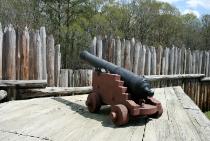
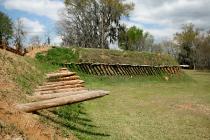
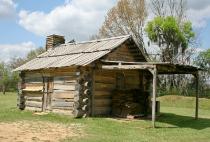
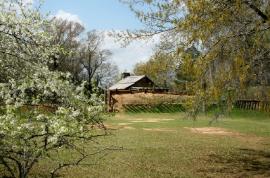
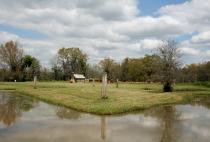
Fort Toulouse-Main Page
Mississippian Mound at Fort Toulouse
Fort Toulouse Reconstruction
Creek War of 1813-1814
Historic Sites in Alabama
Explore other Southern Historic Sites
Mississippian Mound at Fort Toulouse
Fort Toulouse Reconstruction
Creek War of 1813-1814
Historic Sites in Alabama
Explore other Southern Historic Sites

Custom Search

Custom Search
| Copyright 2017 by Dale Cox All rights reserved. Last Updated: August 22, 2017 (Some contents Copyright 2011) |
FORT JACKSON
Wetumpka, Alabama
Wetumpka, Alabama
